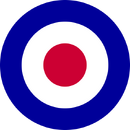The Fairey Fulmar is a 2-seater naval fighter used by Great Britain in World War II
Description[]
The Fairey Fulmar is a two-seater naval fighter designed by the Fairey Aviation Company and used by Great Britain in World War II The Fulmar had a crew of 2, the pilot and the navigator. It was armed with 8 x .303 in machine guns. It used the
Variants[]
[2] Only 2 variants of the Fulmar were ever made:
- Fulmar Mk. I: Initial Production model
- Fulmar Mk. II: Improved engine Rolls-Royce Merlin 30 engines. Improved performance standards for the aircraft
History[]
Design[]
In 1934, the Fairey Aviation Company designed a two-seater monoplane as a day-bomber. This aircraft was called P.4/34. In January 1937 the aircraft flew for the first time as a dive bomber. It suited this role well. Before the P.4/34 was put into production, the admiralty said, that Great Britain needed a new fighter. The Fairey Aviation Company put in an offer to the War Office to meet this new demand. The design was accepted an the day-bomber idea was scrapped, and the P.4/34 was modified and another prototype was made.
Production[]
In May 1938, the aircraft was pushed into production. It was then given its name Fairey Fulmar
Service[]
The aircraft was put into service with No. 808 Squadron in June 1940. By the later part of the year No. 806 Squadron and No. 807 Squadron. In October 1940 with No. 808 Squadron aboard HMS Ark Royal began operations in the Mediterranean, flying convoy patrols and fighter escort.
In 1941, No. 808 Squadron joined No. 806 Squadron and No. 807 Squadron to go up against the Italian Air Force in the defence of Malta (mainly providing fighter escort for convoys). In November of that year, No. 807 and 808 Squadrons reported shooting down 15 enemy fighters in July and August. During this time, the Fulmar proved itself to be a very capable dogfighter.
In the Greek Campaign, the Luftwaffe got involved. It was here when the Fulmar's weak spot was discovered. Due to the lack of rear armament, the six of the Fulmar was very venerable and soon the Luftwaffe started picking Fulmars out of the skies over the Mediterranean.
Despite the Fairey knowing this, they still kept on producing these aircraft and still delivering them to the front line until 1942. By 1943, almost 15 squadrons had been equipped with the Fulmars. In April 1943, the Fulmars were still flying, as valuable fighter escort for valuable cargo in the Indian Ocean, as well as flying as a reconnaissance aircraft. By the latter part of 1943, all Fulmars were replaced by the Fairey Firefly and put into secondary roles. Most Fulmars lived out the rest of the war in these secondary roles.
Squadrons[]
A total of 56 squadrons were equipped with the Fairey Fulmar. (Squadrons will be listed)
No. 700 Squadron to No. 799 Squadron [4]
| 700 | 726 | 731 | 733 | 739 | 740 | 746 |
| 748 | 756 | 757 | 759 | 760 | 761 | 762 |
| 766 | 767 | 768 | 769 | 772 | 775 | 778 |
| 779 | 780 | 781 | 782 | 784 | 787 | 788 |
| 789 | 790 | 792 | 793 | 794 | 795 | 798 |
No. 800 Squadron to No. 897 Squadron
| 800 | 803 | 804 | 805 |
| 806 | 807 | 808 | 809 |
| 815 | 822 | 827 | 835 |
| 879 | 881 | 884 | 886 |
| 887 | 889 | 893 | 897 |
References[]
- ↑ Michael Sharpe, Jerry Scutts, Dan March. Aircraft of World War II; A Visual Encyclopedia. PRC Publishing Ltd. (2000). Page
- ↑ http://www.militaryfactory.com/aircraft/detail.asp?aircraft_id=962
- ↑ Michael Sharpe, Jerry Scutts, Dan March. Aircraft of World War II; A Visual Encyclopedia. PRC Publishing Ltd. (2000). Page
- ↑ http://www.fleetairarmarchive.net/aircraft/Fulmar.htm
I will reference soon

